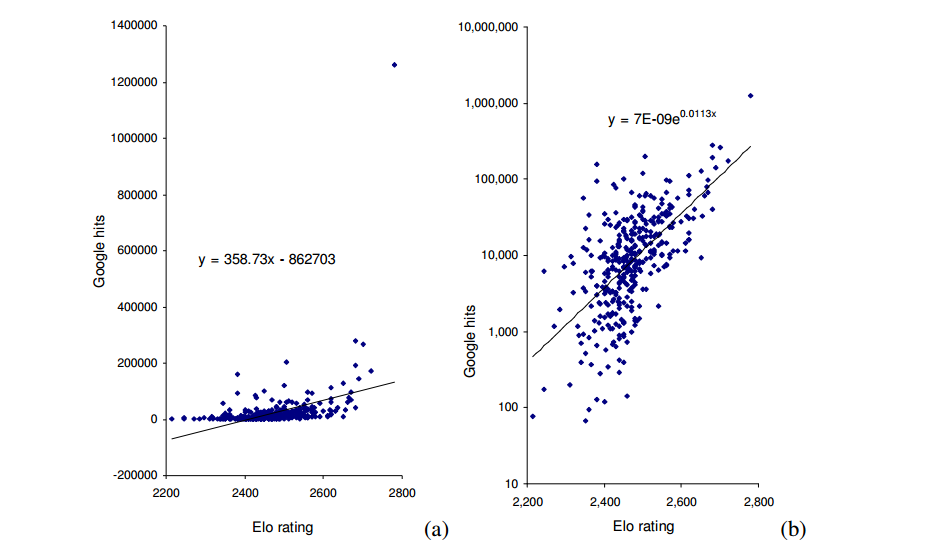How History’s Greatest Chess Players Reveal the Secret Formula Behind Fame
Fame is the state of being known by many people. So a simple measure is the number of hits that a name generates on Google. Indeed, various researchers have used this as a useful proxy for fame.

That has allowed them to ask some interesting questions about the nature of fame. And one that constantly arises is how fame is related to an individual’s achievement—how much more fame does greater achievement bring?
But there’s a problem. While it’s easy to measure fame by the number of Google hits, it’s much harder to measure achievement. So comparisons are hard to make.
Today, Mikhail Simkin and Vwani Roychowdhury at the University of California, Los Angeles, have found a way to solve this problem using the well-studied achievement of top-ranked chess players. This provides a database to compare against fame and so provide a unique insight its nature.
The method is simple. Simkin and Roychowdhury begin with a database of all 371 international chess title holders born between 1901 and 1943 , all of them grand masters and international masters.
Each of these players has a ranking known as an Elo rating, a number that represents the strength of the player based on his or her results against other players. The Elo rating can also be used to predict the outcome of matches between two players.
The system is named after the Hungarian-American physicist Arpad Elo, who invented it. In 1978, he published the rankings of these players in a now legendary book called The Rating of Chessplayers, Past and Present. It is these rankings that Simkin and Roychowdhury use.
They enter each player’s name into Google and count the hits. Then they plot this number against the Elo rating and work out how fame varies with achievement.
This leads to a straightforward conclusion: fame increases exponentially with achievement. The researchers give the example of the American chess prodigy Bobby Fischer, one the most famous chess players in history and also arguably the greatest, and Mikhail Botvinnik, a Soviet grand master who is also thought of as one of the greatest.
Simkin and Roychowdhury have calculated a figure for each player that represents their achievement and compared it to their fame. Botvinnik’s achievement figure is 6 percent lower than Fischer’s and yet he is significantly less famous, running up just 173,000 Google hits versus Fischer’s 1,260,000 hits. In other words, Fischer’s achievement is only marginally greater than Botvinnik’s but he is more than seven times as famous.
This is not the first time that Simkin and Roychowdhury have found an exponential link between fame and achievement. They found a similar link between the achievement of World War 1 fighter pilot aces and their fame.
(There is an interesting difference between fighter pilots and chess players, because a fighter-pilot “win” only occurs when one pilot kills another or causes him to be taken prisoner. That means they never fight again. By contrast, chess players can meet many times. Simkin and Roychowdhury say this distorts the link between fame and achievement in ways that are straightforward to take into account, once the effect is recognized.)
The idea that fame is exponentially related to achievement has some interesting consequences. Simkin and Roychowdhury have already used it to estimate the achievement of Nobel Prize winners based on their fame. “In particular, we found that Paul Dirac, who is a hundred times less famous than Einstein, contributed to physics only two times less,” they say.
That work was based on the fighter pilot analysis alone. “One may argue that this approach is on a shaky foundation since there is only a single actual observation of exponential relationship between achievement and fame,” admit Simkin and Roychowdhury.
So the discovery of a second example provides even more evidence that fame grows exponentially with merit is a handy advance.
Ref: arxiv.org/abs/1505.00055 : Chess Players’ Fame Versus Their Merit
Keep Reading
Most Popular
Large language models can do jaw-dropping things. But nobody knows exactly why.
And that's a problem. Figuring it out is one of the biggest scientific puzzles of our time and a crucial step towards controlling more powerful future models.
How scientists traced a mysterious covid case back to six toilets
When wastewater surveillance turns into a hunt for a single infected individual, the ethics get tricky.
The problem with plug-in hybrids? Their drivers.
Plug-in hybrids are often sold as a transition to EVs, but new data from Europe shows we’re still underestimating the emissions they produce.
Stay connected
Get the latest updates from
MIT Technology Review
Discover special offers, top stories, upcoming events, and more.